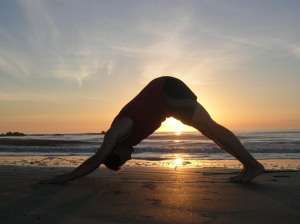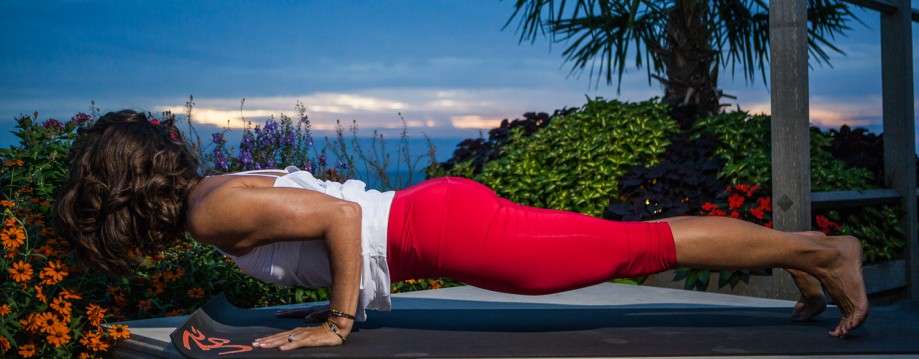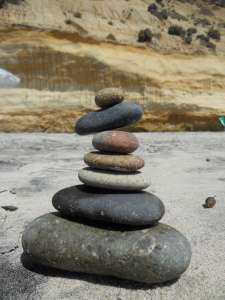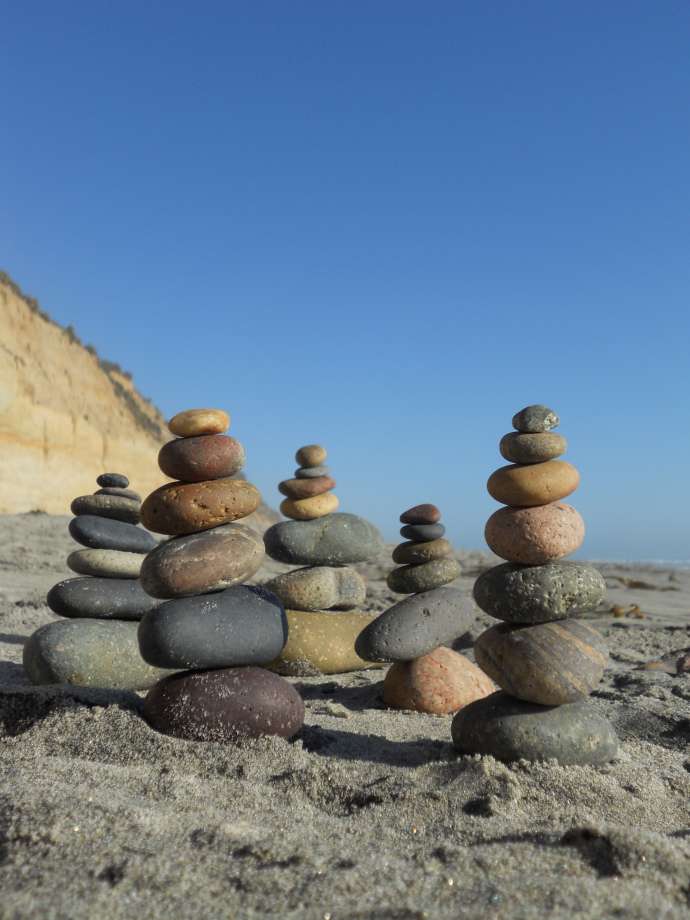I recently read an interesting book called The Dirty Life, by Kristen Kimball. It’s about farming the natural way – no engine based machinery, no herbicides, or pesticides just good old fashion hard work. I’ve always loved the idea of owning a farm but I just don’t enjoy playing in the dirt. I enjoy hard work. I love the simple task of cutting grass with our electric lawn mower. But I just wouldn’t be very good at natural farming because you have to pull the bugs that are eating your plants off by hand and squish them. When it comes down to it, I’m too girly for farming. But I’m not to girly for the work that’s required for a good yoga practice, thank goodness! In this book, the author was writing about her love of farming and I realized her words perfectly described my love of yoga. No surprise, really, because farming and yoga share some similarities. She writes ” I was in love with the work, too, despite its overabundance. The world had always seemed disturbingly chaotic to me, my choices to bewildering. I was fundamentally happier, I found, with my focus on the ground. For the first time, I could clearly see the connection between my actions and their consequences. I knew why I was doing what I was doing, and I believed in it. I felt the gap between who I thought I was and how I behaved begin to close, growing slowly closer to authentic. I felt my body changing to accommodate what I was asking of it… I had always been attracted to the empty, sparkly grab bag of instant gratification and was beginning to learn something about the peace you can find inside an infinite challenge.”
Even if I just took that last line to describe my love of yoga it would suffice, ” I was beginning to learn something about the peace you can find inside an infinite challenge.” Yoga is infinite, there are still poses and breathing techniques my body is still not ready for, nor is my mind for that matter, even after having my practice established as a 6 day a week Ashtanga practice, for the past 12 years. But every word in that farming description fits how I feel about yoga.

Downward facing dog, Adho mukha svanasana
Sullivans Island sunrise!
The author says, “I was fundamentally happier, I found, with my focus on the ground. ” Downward facing dog is just that, connecting to the ground, drawing my attention downward and inward. I have always found yoga to be very primal. For starters, you are barefoot the whole class and you’re mostly on the ground with all four’s, or more. How your body is interacting with the ground determines the success or failure of your yoga practice. Headstand is a great yoga pose that can easily help you understand the line that says ” For the first time, I could clearly see the connection between my actions and their consequences.” And because students are usually forced to slow down and deal with what some of the consequences are in yoga, such as injury, or embarrassment from falling down, they are forced to grow and to feel their body changing to accommodate what they are asking of it.
There is also no short cut. A dedicated yogi, one that has stuck with it consistently, knows that the only way you achieve some of the bizarre postures we do, is good old fashioned hard work. The author also says of farming, ” Question: Why is farming like a relationship? Answer: Because you do not reap what you sow. That’s a lie. You reap what you sow, hill, cultivate, fertilize, harvest and store.” In yoga, you reap what you face, repeat, lift, tuck,sweat through, and breathe into.
But brute strength can only get you so far. There has to be a degree of finesse and a nice increase of knowledge (vidya) with each practice. Yoga is cumulative in effort. The more effort you put forth the more return on your investment. And what are you investing in anyway? Only the greatest gift you have ever received…your health. I recently saw an infomercial for a Pastor selling a book about taking care of your body with exercise, I think they called it “Bod for God”. It’s premise was, the best way you can thank God, and show your appreciation, and devotion to God is to take care of the beautiful body he/she gave you….DUH! I’ve known this for years. The greatest show of thanks I can give to the divine everyday is treating my body well. Just as a farmer has to treat the earth well.
The really good farmer knows what hard work is. A good farmer knows that to produce a crop, a healthy crop, it takes attention to detail. From the grounds composition, to the weather patterns, to the hours of daylight and to the critters/invaders that try and eat his crop, he knows and does it all. A day off means a day that a bug or disease can get a jump on him and destroy his whole crop. Farmers know their land, they know how to see the smallest change in environment and how that might effect his/her outcome. We all need to become more like farmers. We need to pay attention to the details. We need to know our environment and how it’s effecting our mental and physical well being. If we want to live a productive life, as much as a farmer wants to have a productive crop, then we need to tend to matters.
It starts with the soil. In the case of the human body, your soil is your mind. It’s where all thoughts begin. It is the point of creation. Your mind needs to be open in order for creative thoughts to flow through. Just like the ground that a farmer wants to plant, it must be loose and fertile, with out rocks, weeds, and bugs. Ground that is compact and dense will suffocate the life right out of any seed. So it starts with the soil, it needs air, nutrients and moisture. Which is why farmers till the soil, over and over until its ready for the seeds. Your mind also needs air and movement, it needs to be fertile for the right things to grow. A yoga practice can do just that. Sutra 1.2 says “Yogas citta vrtti nirodhah”; yoga can make the mind less fickle, that’s my personal translation. Yoga is a moving meditation. The movement, opens things and the meditation part is like the sun, shining light onto things that need to grow. Meditation is simply the process of observation, which will expose the things that would pull you away from a productive and fruitful life. A yoga practice is equivalent to the farmer walking his acres every morning and seeing what has transpired over night, knowing his land and keeping a handle on the things that can get out of hand quickly.
Weeds can quickly take hold and suffocate a plant. How many weeds are there growing in your head. A great example of a weed in your mind is a repetitive, negative thought where you are putting yourself down. That will suffocate anything good that’s trying to grow in your mind. Where a narrow mind is like dense soil, the density will not allow anything new to come into your perspective, leaving you stuck in repetitive patterns, that are producing the same results (this is the hala hala, poison). The bugs are like other peoples thoughts and opinions that have come in and tainted your view point, especially if you haven’t formed your own well thought out opinion first. Too much rain will drown the crop, because too much of anything is bad…moderation! Too little light, rain or nutrients is also bad. Just remember this, in yoga it is the terrible two’s that will get you in trouble; too much, too soon, too fast, and too little rest. It’s all about balancing opposing forces (dwandwa, twoness – duality).
Be the best farmer of the crop you are trying to produce in your life. I know and believe Old McDonald would have been a great yogi, had he had the time. Who’s to say he wasn’t a yogi, just without the asana’s? Keep this last thought in mind from The Dirty Life ” Of course we have a chance, he’d say, and anyway, it didn’t matter if this venture failed. In his view, we were already a success, because we were doing something hard and it was something that mattered to us. You don’t measure things like that with words like success or failure, he said. Satisfaction comes from trying hard things and then going on to the next hard thing, regardless of the outcome. What mattered was whether or not you thought you were moving in a direction that was right.” Just like sutra 1.12 says “Abhyasa vairagyabhyam tannirodhah.” ; steady practice with non-attachment, steady practice with non-attachment, steady practice with non-attachment, worth repeating because that one is tricky.
And one last thing to keep you steering the plough in the right direction is this line from a documentary I recently watched called Enlighten Up,” It doesn’t matter what you are doing, but why you are doing it.” We can so easily forget the why because we are so focused on the what. For me, when I’m on my mat it goes back to what the Author, Kristen said which is “I knew why I was doing, what I was doing, and I BELIEVED IN IT.” Well said.
Old McDonald had a yoga practice E - I – E - I Ommmmmmmmm!
I believe in yoga, enough said.


